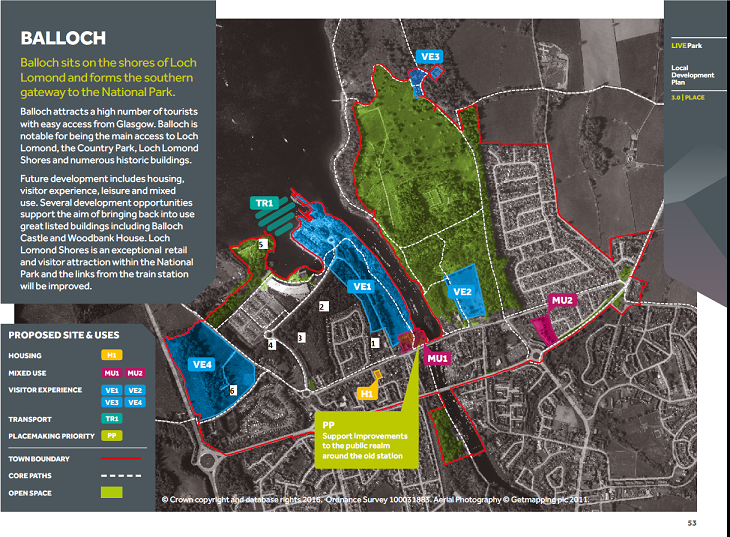
The 28 day statutory minimum consultation period on the revised Flamingo Land Planning Consultation ends on Monday when Green MSP, Ross Greer, is due to hand in over 52,000 objections he has helped gather to the Loch Lomond and Trossachs National Park Authority. The LLTNPA, to it credit, has said that it will continue to accept objections after this date although its unclear whether they will alert the public to the final closing date for objections. Its safer therefore, if you have concerns, to lodge them sooner rather than later.
Parkswatch has, over the last six months, described why the development is, in planning terms, wrong in principle (see here) and (here). Recent submissions on the Park’s Planning portal (see here), mostly from locally residents, have offered more detailed critiques of specific issues. These add considerably to the overall case against the development. This post takes a look at what they say in the hope that this will inspire more people to lodge detailed objections.
Impact of the proposed staff service area and entrance hub
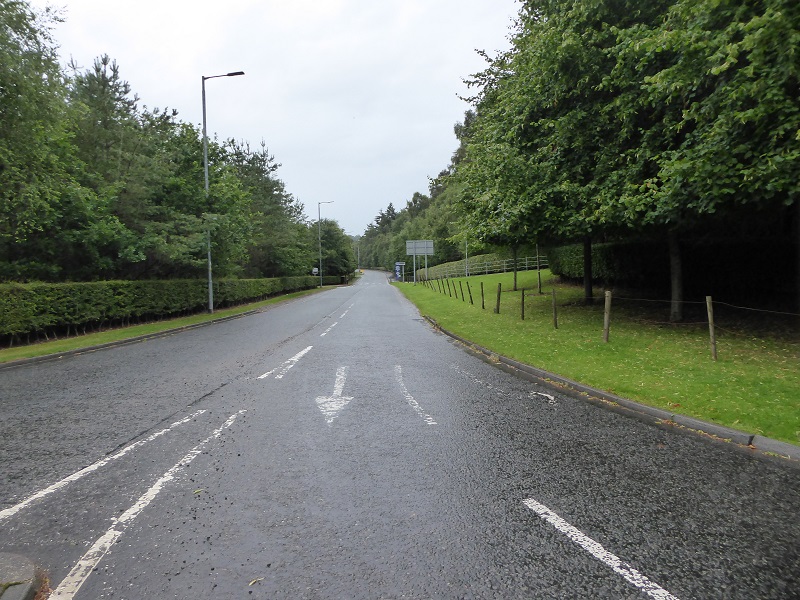
Local resident Geoffrey Hull has submitted a detailed critique of the service proposed area which will be located in woodland off Ben Lomond Way. His objection is well worth reading (its got maps and diagrams and is too big to upload directly but you can get it from the Park Planning porta). He is concerned about the impact the service area will have on woodland, on bats and on traffic – when combined with the entrance hub to Flamingo Land which will be located off the car park opposite. He has undertaken a detailed examination of Flamingo Land’s bat survey and traffic projections (see more on this below) and shown these are totally inadequate.
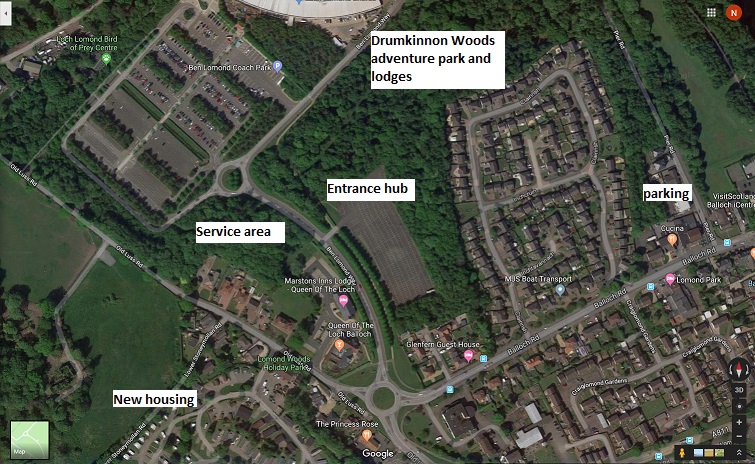
Geoffrey’s objection made me realise that there appear to be no descriptions anywhere in the Design Statement about the proposed Service Area apart from that it will be c900 square metres in size. Nor are there any details provided of the proposed Entrance Hub apart from that it will be c2000 square metres. Nothing about the height, proposed design or what each building will be actually be used for (site laundry for the service area?). In addition, for the Service Area there appears to be no indication of what parking is proposed.
What’s more, this proposed service building lies in an area of land which has NOT been earmarked for development in the Local Development Plan and the Planning Application provides no justification for developing it. Its unclear to me if the Entrance Hub building is to be built on the car park or in the woodland but no consideration is given to whether both buildings, if they are needed, might not be better located elsewhere? In the overflow car park for example rather than in woodland.
Adequacy of Wildlife surveys
Geoffrey also provides a clinical dissection of the bat survey submitted by Flamingo Land. As I said, its worth reading in its entirety, but here is part of his conclusion:
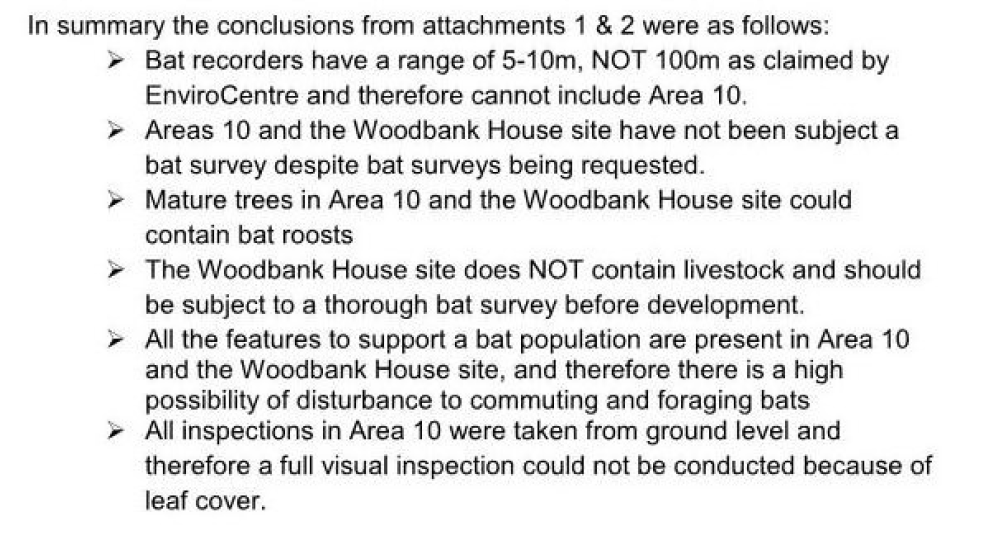
From the evidence Geoffrey presents, I have little doubt this is true: the bat survey presented by Flamingo Land appears totally unreliable. That is important because, in development terms, bats are protected species and full surveys are legally required before a development can go ahead. The wider implications, however, are very worrying. Can the LLTNPA or the public rely on ANY of the wildlife survey information submitted by Flamingo Land in support of their application? Can the LLTNPA really conclude that the whole site is of little consequence in terms of conservation on the basis of the surveys submitted?
Capacity of existing Scottish Water infrastructure
Another local resident, Kenneth Gibson, has provided detailed comments (see here for full document) on the adequacy of the water supply and sewerage relating to the proposed development at Woodbank House:
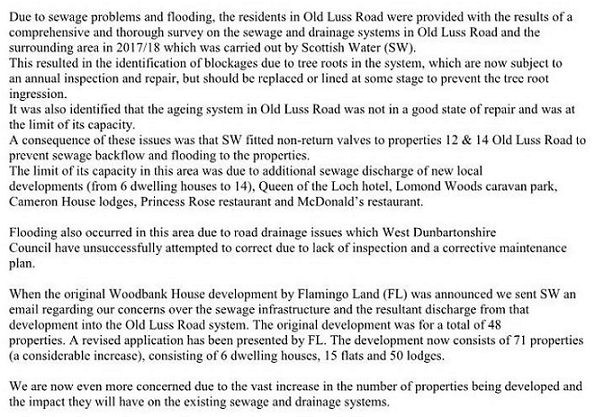
Flamingo Land’s Design and Access statement has a section on development constraints and under the heading “utilities” has this to say about water:
” a water main cuts across the south west corner of the Woodbank site”.
Scottish Water, in their response to the application dated 30th April state the applicant needs to provide both a water and a drainage impact assessment. This is to enable them to decide whether they can provide sufficient water to the development (existing capacity is likely to be sufficient) and then carry away and treat the waste water (not known). Flamingo Land appear not to have provided this as yet. As Kenneth explains, the significant increase in the size of the proposed development at Woodbank House and the creaking existing capacity could make the whole development unviable.
The bigger issue, of course, is the capacity of the existing infrastructure to drain and then treat waste water from the site as a whole. Its amazing that the LLTNPA, which has a statutory duty to promote “sustainable development”, has not yet apparently required Flamingo Land to provide information on this, signed off by Scottish Water, BEFORE considering whether to grant Planning Permission in Principle.
Impact of additional traffic and parking
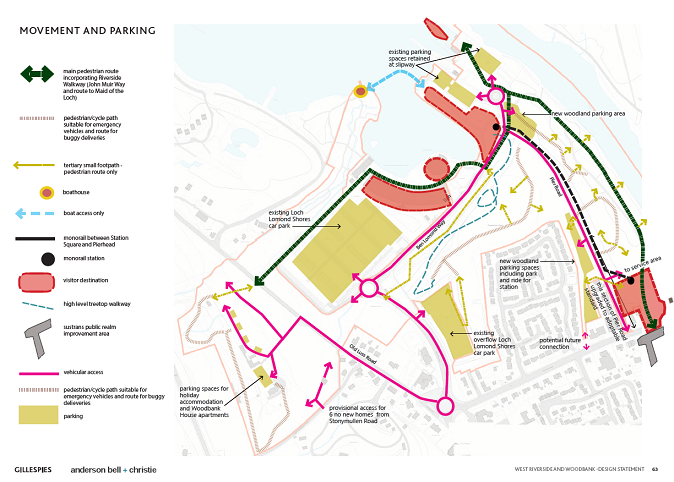

The Application indicates that the number of additional parking spaces Flamingo Land is proposing to create is “up to 350”, which is quite vague but a significant addition to existing capacity. It will destroy yet more woodland and part of at least one car park (1 on top map, lower right map above) is outwith any land earmarked for development. How much parking there may be in the staff service area is not indicated.
Other local residents have raised a number of very important questions about the proposal to bring more cars to Balloch, including the quality of the traffic surveys, the impact on congestion on Ben Lomond Way (the entrance to Lomond Shores AND the new resort), the knock on effect of gridlock on the A82 (queues are already miles long on holiday weekends), how the size of the proposed lodges relates to the number of parking places, the impact on pedestrian routes, increased air pollution etc. In contrast to Highland Council, which provided very critical commentary on the traffic impact assessment produced by Natural Retreats for the new Ptarmigan restaurant, West Dunbartonshire Council has been almost totally silent. One wonders why when the adverse consequences of attracting yet more traffic to a village that already can’t cope is so obvious.
Impacts of the proposed access to the new luxury housing on the Woodbank House site
A couple of local residents have critiqued the proposals to route access to the euphemistically described “low density housing” on land earmarked for “Visitor Experience”. This is being proposed as an “enabling development” along the southern edge of the Woodbank House site from the Stoneymollan Rd.

Flamingo Land’s map showing movement and parking (above) describes access to the new housing (pink arrows bottom left) as “provisional”. Strangely, this map shows the John Muir Way (thick green line) as ending on the Old Luss Rd. In fact the John Muir Way turns south down Old Luss Rd and then carries on up the single track Lower Stoneymollan Rd. Hence some of the concern from local residents.
Impact on cultural heritage
The whole of the West Riverside site has a very interesting history. It is gratifying therefore to read that the West of Scotland Archaeological Service has not just commented on the application (see here) but repeated its advice that a full survey be conducted BEFORE any development goes ahead:
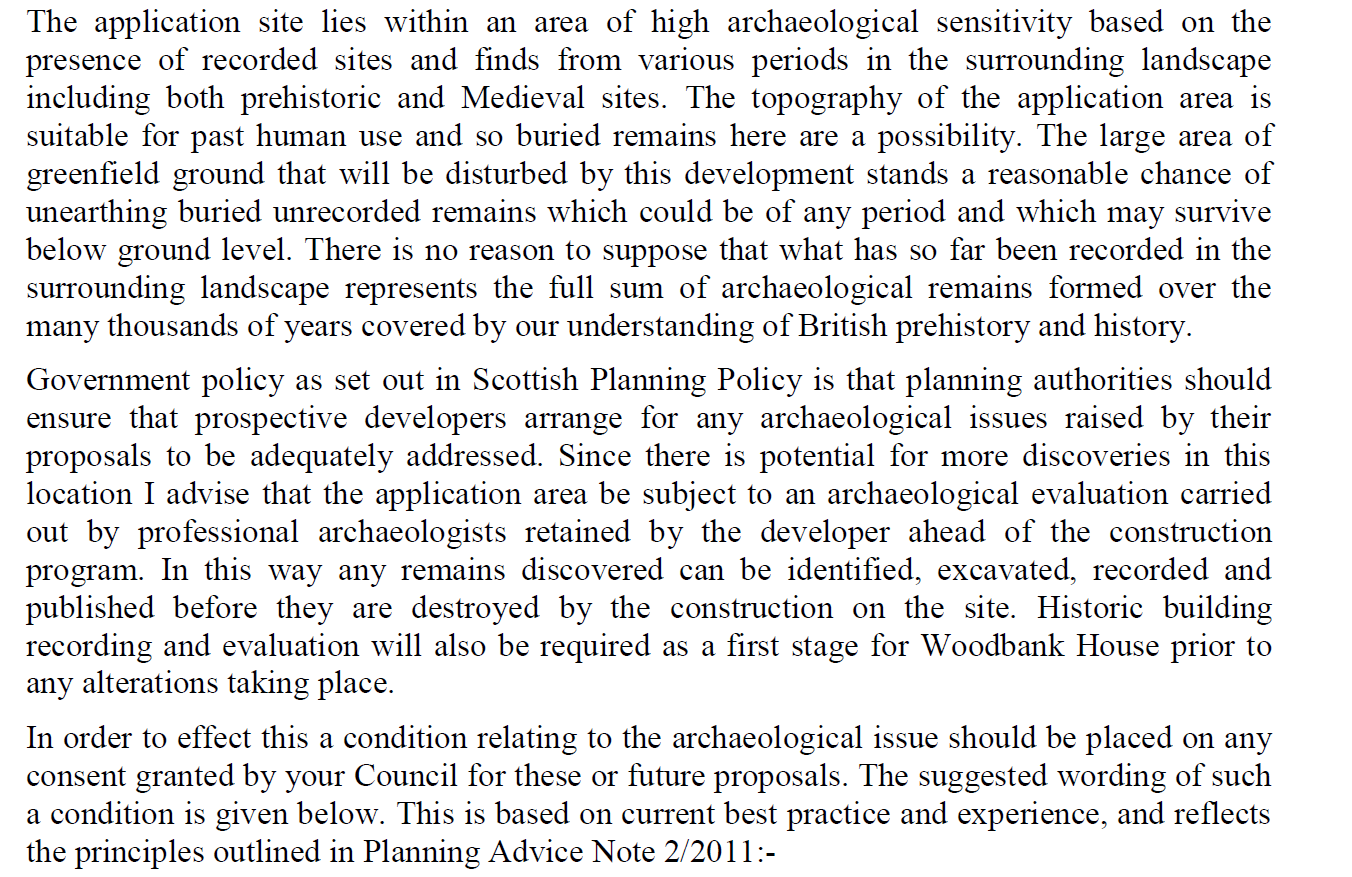
Flamingo Land’s Environmental Statement took a very narrow view of the cultural worth of the site. It limited its assessment to the historic buildings and Woodbank House and the Pierhead area, rather than considering the history of land-use on the site as a whole. That would have highlighted the need for thorough archaeological investigations.
The wider issue that this highlights is that Flamingo Land has included NOTHING in its application for Planning Permission in Principle that would celebrate or commemorate the cultural heritage of the area. To me, the one development which might fulfil the statutory aims of the National Park in the Pierhead area, is a museum or other type of interpretative facility – designed to enhance the setting of the steam slipway and Maid of the Loch. This could display artefacts recovered from the site, including during any construction works, and interpret how the multiple uses people have made of this land over the last few centuries relates to the natural history of the loch.
Unfortunately the LLTNPA has in the last few years been very weak on promoting the cultural heritage of the Natural Park. It did nothing, for example, to enable the local community in Strathfillan to realise their aspiration of a mining museum at Tyndrum when it gave the go ahead to the Cononish goldmine. Its has also failed to make the most of its founding aspirations and steadily closed its Visitor Centres, including the one at Loch Lomond shores. The WOSAS response is a reminder that unless more people press for the LLTNPA to make interpretation of the cultural heritage integral to the gateway to Loch Lomond, this is unlikely to happen.
What needs to happen
What these submissions show is that the more Flamingo Land’s proposals are subject to detailed scrutiny, the less they stand up. The LLTNPA is far too close to Flamingo Land, having sat on the interview panel which appointed them as preferred developer, and has allowed them to submit a revised Planning Application which is far below what we should expect in a National Park. The evidence presented in this post suggests that before LLTNPA staff present the Planning Application for decision they need to:
- Require Flamingo Land to submit more details about the design and purpose of the Entrance Hub and Service Area on either side of Ben Lomond Way
- Require Flamingo Land to produce specific justifications for all the land where development is proposed which lies outwith land earmarked for development in the Local Development Plan
- Ask West Dunbartonshire Council to take a far more critical look at the likely increase in traffic which will result from the proposed development
- Require Flamingo Land to address inconsistencies in information presented in different parts of the Application so its clear what is actually being proposed (the inclusion/omission of the John Muir Way from different maps being just one example)
- Require a proper assessment of the impact of the development on water and sewerage systems
- Require Flamingo Land to provide an assessment of all access options to the proposed new housing on Stoneymollan Rd to ascertain if the issues raised by objectors could be addressed
- Subject all wildlife surveys submitted by Flamingo Land to independent scrutiny
- Ask Flamingo Land to extend its consideration of the impact of the development on the cultural heritage of the area to the whole site and not just the historic buildings
It will be interesting to see whether, in the light of recent objections, the LLTNPA try to rush the Flamingo Planning Application through or whether they require the developer to supply more information such as suggested here.
Fantastic research and every point made should have been picked up by the various organizations and agencies involved in the decision making process of this proposal. I’d like them to answer WHY there has been no transparency regarding these very important issues.
No this is a national park , loch Lomond is absolutely the wrong place for this , there should be an outcry about this
Something I find astounding about this Major Application, albeit Planning in Principal, is that it has never been on the Agenda of the Planning and Access Committee. I have trawled right back to May 2016 and can find no trace of it coming up even under AOB. The May’19 monthly Meeting was “Cancelled – no Committee business required.” 2018 saw only 4 Meetings of this Committee since Flamingo Land submitted their PPP in May’18; July, September and December being cancelled for the same reason. I also wonder if the change of name to Lomond Banks does not require a re-submission? As usual this is a very high quality posting containing many very relevant points. It is also heartening to see people other than yourself, Nick, doing in-depth research into this application.